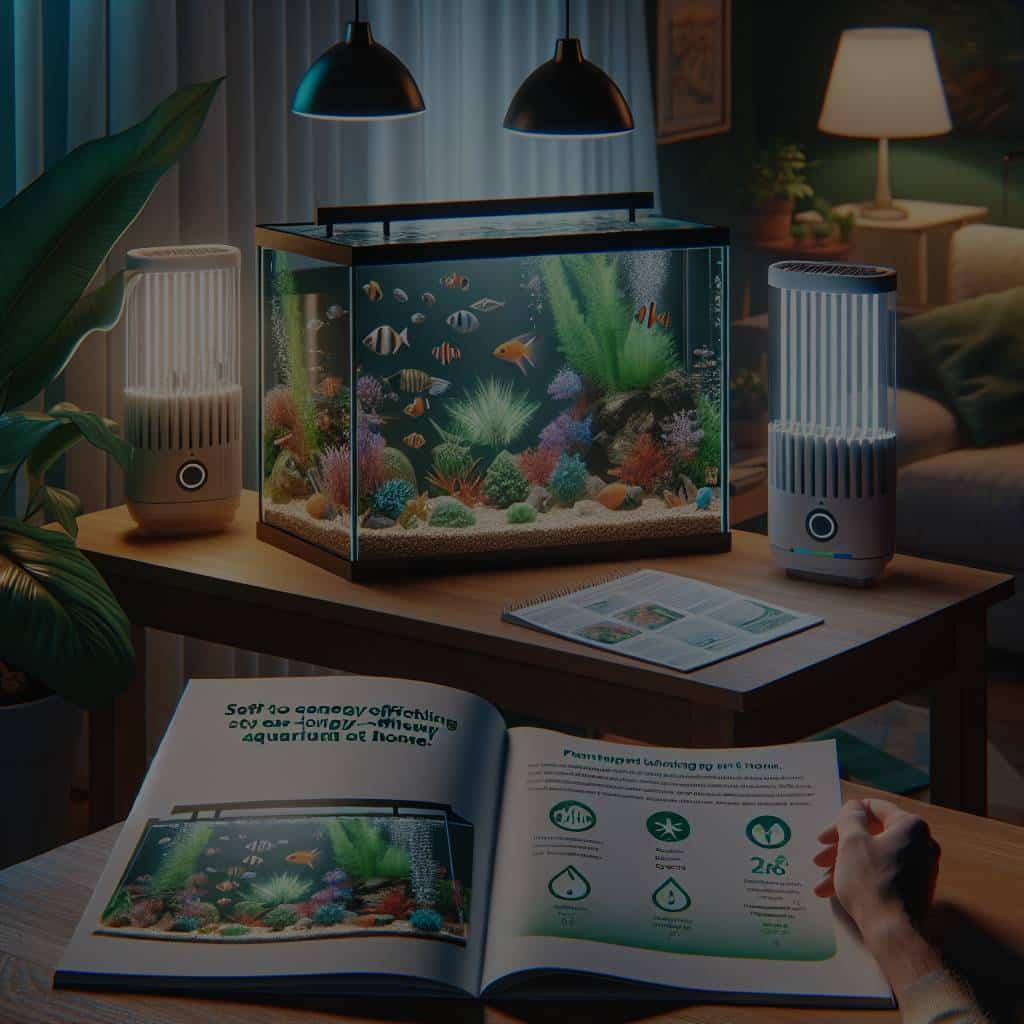How to Create an Energy-Efficient Aquarium Setup at Home?

The mesmerizing sight of fish swimming in a beautifully adorned aquarium can create a calming ambiance in any room. As enchanting as it may be, maintaining a healthy and vibrant aquarium means ensuring the right balance of light, heat, and water flow. This requires an ensemble of equipment including pumps, filters, heaters, and lighting systems—all of which consume power. Hence, the quest for an energy-efficient aquarium becomes not only an ecological but also an economic imperative. In this article, you will learn how to create an energy-efficient aquarium using various techniques and principles.
Choosing the Right Aquarium: Size and Material Matter
Before you start buying your aquarium inhabitants and the necessary equipment, it’s crucial to pick the right aquarium or tank. The size and material of your tank play a significant role in determining how much energy it will consume.
A lire en complément : What Are the Best Organizational Systems for a Home Library by Author?
A larger tank certainly offers more room for a variety of fish and aquatic plants, but it also requires more energy to maintain. Keeping the water clean, oxygenated, and at the appropriate temperature in a large tank demands more work from your pumps, filters, and heaters—increasing energy consumption. Therefore, if energy efficiency is a key concern, consider going for a smaller tank.
The material of your aquarium also influences its energy efficiency. Traditionally, aquariums are made of either glass or acrylic. Glass tanks are more common, but they are less insulative than acrylic tanks. This means that glass tanks lose heat more quickly, causing the heater to work harder and consume more energy. On the other hand, acrylic tanks provide better insulation, helping to reduce energy consumption.
A découvrir également : What Are the Best Native Perennials for a Low-Maintenance Home Garden?
Opting for Energy-Efficient Equipment: Pumps, Filters, and Heaters
The equipment you choose to keep your aquarium functioning smoothly can significantly impact its energy efficiency. This includes your pumps, filters, and heaters.
Pumps are vital for circulating water in the tank, creating currents, and providing oxygen for the fish. When looking for energy-efficient pumps, opt for those with adjustable flow rates. This allows you to control the amount of energy consumed by reducing the flow rate when necessary.
Filters, similar to pumps, are necessary to keep the water in your aquarium clean and safe for your fish. There are various types of filters available on the market, but not all are created equal in terms of energy efficiency. Canister filters, for instance, are highly efficient but can consume a lot of power. On the other hand, sponge filters and hang-on-back filters consume less energy and are still effective in keeping your tank clean.
Heaters are equally important in an aquarium setup, especially for tropical fish that require warmer water. Again, energy efficiency varies widely among different types of heaters. Submersible heaters are generally more energy-efficient than hanging heaters. Also, look for heaters with thermostats which automatically turn off when the desired temperature is reached.
Using Solar Energy: A Sustainable Alternative
Harnessing solar energy is an excellent way to power your aquarium and reduce your carbon footprint. Solar panels can generate enough power to run your aquarium’s lighting, heating, and filtration systems.
Solar-powered aquarium systems are not entirely new, but the technology has significantly improved over the years. Today, there are specific pumps, filters, and heaters designed to run on solar power. Although the initial setup cost may be higher, the cost savings in the long run make it a worthwhile investment. Moreover, relying on solar power reduces your dependence on the grid, making your aquarium setup more resilient during power outages.
Lighting Considerations: LED and Timers
Proper lighting is essential in aquariums, especially if you have live plants or coral reefs that rely on light for photosynthesis. Traditional incandescent bulbs consume a lot of energy and also generate excess heat which can disrupt the temperature of the tank. Hence, LED lighting is the preferred choice for energy-efficient aquariums. LED lights consume less energy, generate less heat, and have a longer lifespan than traditional bulbs.
Moreover, using a timer for your aquarium lighting can further enhance energy efficiency. Fish, plants, and coral reefs don’t need constant light. They require a period of darkness to rest and grow. Thus, timers can be programmed to turn lights on and off at specific times, mimicking the natural day-night cycle and saving energy in the process.
Live Plants and Algae: Natural Filters and Oxygenators
Incorporating live aquatic plants and algae in your aquarium setup can also contribute to energy efficiency. Plants act as natural filters, absorbing harmful nitrates and other toxins from the water. This can reduce the workload of your mechanical filters and, consequently, their energy consumption.
Furthermore, plants produce oxygen during photosynthesis, which can decrease the reliance on mechanical aeration from pumps. However, it’s important to maintain a balanced plant-to-fish ratio to ensure enough oxygen supply for your fish.
Algae, although often considered a nuisance, can also contribute to an energy-efficient aquarium. Certain types of algae, like macro-algae, can help control nitrate and phosphate levels in your tank, reducing the need for frequent water changes and filter maintenance.
Creating an energy-efficient aquarium setup at home involves thoughtful planning and careful selection of the aquarium size, materials, and equipment. Embracing solar energy and LED lighting, along with incorporating live plants and algae, can collectively help reduce energy consumption and make your aquarium more sustainable. By doing so, you are not only saving on your energy bills but also contributing positively to the environment.
Implementing a Regular Maintenance Schedule: A Key to Efficiency
The path to an energy-efficient aquarium is not only about choosing the right tank and equipment, but also about adhering to a regular maintenance schedule. Regular maintenance includes cleaning and water changes, which are crucial to maintaining the overall water quality of your tank.
Cleaning your aquarium regularly is important for preventing the buildup of waste and algae, which can hinder the effectiveness of your filters and pumps, thus increasing their energy consumption. This includes cleaning the tank walls, substrate, and any decorations or rocks that may harbor detritus or algae.
Water changes are equally critical for maintaining a healthy and energy-efficient aquarium. Over time, the water in your aquarium can accumulate toxins, excess nutrients, and other unwanted substances that can be harmful to your fish and plants. Regular water changes help to remove these substances, maintain the optimal water quality, and reduce the workload of your filters. Generally, it is advised to change 10% to 20% of the tank water each week, depending on the size of your tank and the number of inhabitants.
It is also advisable to regularly check and service your aquarium equipment. This includes cleaning your filters, inspecting your pumps for any signs of wear or damage, and ensuring that your heater and lights are functioning properly. Regular maintenance will ensure that your equipment is running optimally and efficiently, thereby reducing power consumption.
The Role of Fish in Energy Efficiency: Choose Wisely
The choice of fish species for your aquarium can also have an impact on energy efficiency. Different fish species have different needs in terms of water temperature, lighting, and water flow. Therefore, choosing fish that have similar needs can reduce the need for additional or high-powered equipment.
For instance, choosing freshwater fish for your freshwater tank that are comfortable in room temperature water means you can potentially forego the need for a heater, saving on energy consumption. Similarly, if you choose fish that are adapted to low-light conditions, you can reduce the intensity or duration of your aquarium lighting, further enhancing energy efficiency.
Another consideration is the number of fish in your tank. Overstocking your aquarium can lead to a rapid buildup of waste, demanding frequent water changes and placing additional strain on your filters and pumps. On the other hand, a moderately stocked tank will help maintain a balanced and stable environment, reducing the need for high energy output from your equipment.
Conclusion: A Step Towards an Eco-Friendly Hobby
Creating an energy-efficient aquarium setup at home requires thoughtful planning, the right choices, and regular maintenance. Be it the selection of the tank size and material, opting for energy-efficient equipment like pumps, filters, heaters, and LED lights, incorporating live plants and algae, harnessing solar power, or even carefully choosing your fish species—all of these factors contribute to reducing power consumption and making your aquarium more eco-friendly.
Remember, an energy-efficient aquarium is not just about saving on your energy bills. It’s also about contributing to a more sustainable environment. So, whether you’re a seasoned aquarist or a beginner, taking these steps towards energy efficiency will help you enjoy your hobby in a more responsible and sustainable way. And, as a bonus, your fish and plants will thrive in a healthier and more balanced environment. So, start your journey towards an energy-efficient aquarium and notice the difference, not just in your home, but in the world around you.
